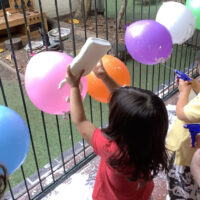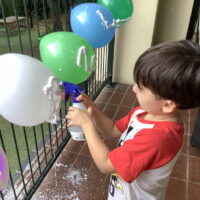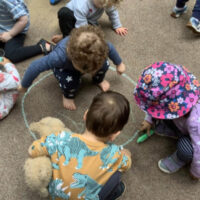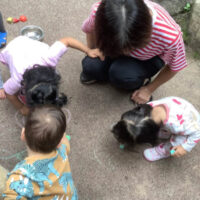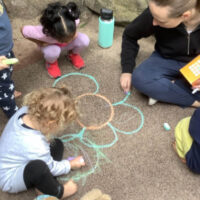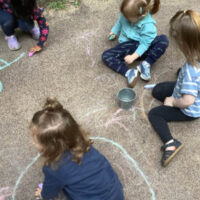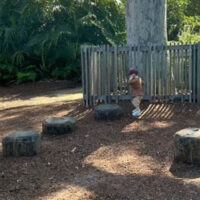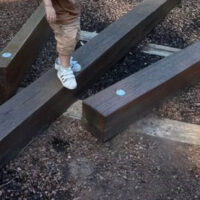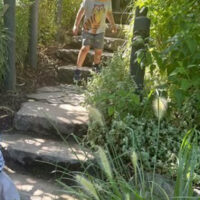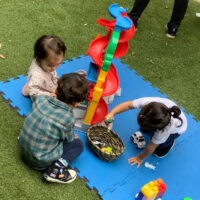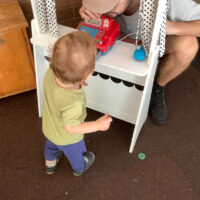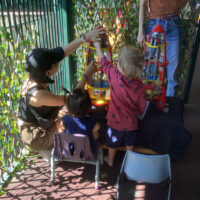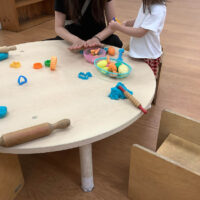Johnson House
Banksia Room
Story by Speech Pathologist Hannah
We recently had a blast with balloons in Johnson House Banksia preschool room. All the children were encouraged to try different spray bottles to squirt or spray letters and numbers created with shaving foam off colourful balloons.
We spoke about how we were going to listen for the first sound in our name. This is a relatively new concept for most of the children in Banksia. I sang a song ‘If your name starts with s, s, s, s, (for example) come and get a spray bottle’. We then talked about other words that begin with those sounds e.g. sun, snake, star, sauce, sand, sea etc…
Letter exposure is an essential part of learning to read, and using play-based and motivating games such as this can help children learn not only the letter formation but also taps into their phonological awareness skills as they think about other words that begin with letter sounds. We call the development of this ‘grapheme to phoneme correspondence’, meaning that children are learning to link the auditory sound to the visual symbol (letter).
When children are exposed to literacy learning through hands-on, practical and play-based experiences, they are more likely to engage meaningfully and successfully with them. When it comes to strengthening hands and fingers, spray bottles are hard to beat! Not only do they activate hard to reach muscles in the fingers, but the pumping action strengthens their small muscles, especially in their thumbs.
Murray House
Jacaranda Room
Story by Educator Cathy
The Murray House Jacaranda children recently explored mark-making. The children have shown interest in drawing and creating shapes and lines with intention, drawing lines and creating marks to mimic letters, numbers and shapes. With the yard as our canvas, the children set to work, making large marks across the ground. The children observed as our educators demonstrated how to draw different shapes and letters. The children then used their own chalk to trace and colour in these markings.
The children are beginning to show an interest in communicating through written text and images, and creating pictures that tell stories and represent ideas. Through experiences such as this, the children are developing their pre-writing skills, and can share their thoughts and ideas with an audience. Chalk drawing is a social experience for many children, as they discuss colours and shapes, and talk about the shapes, lines and pictures they are creating.
Family Day Care Sydney Wide
Story by Educator Support Officer Alix and Educator Una
Una’s Family Day Care in Randwick places a huge emphasis on engaging with the local community, as it is through young children’s lived experiences, explored through different social contexts, that their sense of global citizenship grows. On this occasion, Una took the children to The Ian Potter Children’s WILD PLAY Garden, in Centennial Parklands, which was a wonderful opportunity for the children to immerse themselves in an oasis of nature-play and adventure. This is what Una had to say about their visit:
Our children love nothing more than being outdoors exploring in nature and learning about the natural world around us! On Friday we went to Ian Potter Children’s WILD PLAY garden! We practiced our balancing skills on the branches, explored the flower garden, ran through the tunnels to jump into the sand pit and ran curiously through the trees with our friends!! An amazing day helping to build our confidence, physical abilities and support our cognitive growth.
Community Playgroups
Story by Playgroup Coordinator Rebecca
Recently the Playgroup team has noticed a lot of collaborative play happening at our playgroups.
Collaborative play happens when children solve a ‘problem’ by working together to reach a common goal. Often, we think of this type of play as only occurring between children, but collaborative play can also occur between children and adults.
Games with rules, imaginary play and group activities are all examples of collaborative play. In our story’s photos we can see examples of collaborative play occurring between groups of children and between children and adults. There are children sending cars down the garage ramp, working out how to take turns and how to share the garage and cars, the common goal being that all the children want to play with the same toy. This was a perfect opportunity for the children to develop their problem solving and teamwork skills to make sure that everybody could ‘win’.
Playing with an adult can also be collaborative as an adult and child work together to achieve a common goal, which is often to have fun. This is where children learn the to and fro of conversations, turn taking and learning from a trusted adult. Imaginary play scenarios, such as playing shop, foster the development of children’s social skills by mimicking scenes they may see in real life. This helps to increase their confidence and develop their social skills.
Collaborative play also helps children to develop self-control, empathy for others, communication and problem-solving skills, and sharing and leadership skills.
